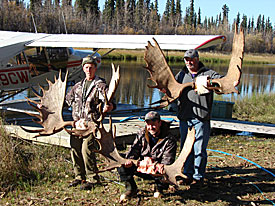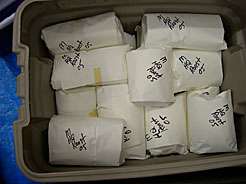FROM ADF&G
 Alaska's hunting reputation is justly deserved. One-fifth the size of the entire United States, Alaska offers wilderness hunting opportunities found in few other locations in the world. It is true that huge moose occur here and that vast caribou herds dominate the landscape in some areas and seasons. Numerous mountain ranges support populations of Dall sheep and mountain goats, and Sitka black-tailed deer thrive in the coastal forests. Once extirpated from the state, muskox now range over the western and arctic coastal wilderness. Large numbers of black and brown bear also exist here. And wolves, which are found across most of the state, are also abundant in some areas. See the summary table Alaska Big Game Distribution, which briefly describes Alaska’s game and where it is located, or refer to individual species descriptions.
Alaska's hunting reputation is justly deserved. One-fifth the size of the entire United States, Alaska offers wilderness hunting opportunities found in few other locations in the world. It is true that huge moose occur here and that vast caribou herds dominate the landscape in some areas and seasons. Numerous mountain ranges support populations of Dall sheep and mountain goats, and Sitka black-tailed deer thrive in the coastal forests. Once extirpated from the state, muskox now range over the western and arctic coastal wilderness. Large numbers of black and brown bear also exist here. And wolves, which are found across most of the state, are also abundant in some areas. See the summary table Alaska Big Game Distribution, which briefly describes Alaska’s game and where it is located, or refer to individual species descriptions.
If marine mammals, wolf, and wolverine are considered, Alaska has over a dozen species of big game animals. However, big game densities are generally much lower than you may be used to in more southerly states and provinces. The state’s relatively cooler soil temperatures and short growing seasons can limit terrestrial productivity, with many game species in Alaska making long movements between seasonal ranges. Some species such as caribou and moose are widely distributed. However, depending on the month, they may be scarce in some areas—even where good habitat exists—and abundant elsewhere.
Alaska doesn't lend itself well to day hunts or short weekend hunts for most big game species. Many hunters find it best to plan and save up money and vacation time for one or two good 5-day or week long hunts a year. Given the uncertainty of weather and animal movement patterns, any additional days you are able to spend in a particular hunting area can really increase your odds of success.

Moose meat, ready for the freezer
Planning and preparation are the keys to a successful hunt, no matter how you define it. Do your homework to determine the best areas and times to hunt the species you seek. Purchase reliable equipment, and practice with it ahead of time. Be prepared physically and mentally for tough weather, difficult terrain conditions, isolation, and weather delays. All are normal features of many Alaska hunts.
This website has been designed to provide the novice and expert hunter alike with useful information on hunting in Alaska. The website covers a wide range of topics, from animal life history and tips on optics, to meeting legal requirements related to hunt reporting, meat care and transport of firearms through Canada. It does not take the place of the Alaska Hunting Regulations. Familiarize yourself with the regulations and carry a copy with you into the field. You may be glad you did, especially if you get weathered in for a day or two with nothing else to read.
We suggest you also obtain local information from private sources and government agencies before making firm plans. Consider taking the Alaska Hunter Education course, it's a good one. You may also want to take advantage ofAlaska Hunting Clinics offered for various species. Finally, feel free to seek more information about regulations or wildlife populations by checking with biologists at our regional offices, and with providers of transportation services. Taking advantage of these resources can help ensure that you have a safe and enjoyable hunting trip, and increase your chances of harvesting an animal.
| Species | Distribution |
|---|---|
| Black bear | Found throughout forested regions of Alaska. Greatest densities occur in parts of Southeast Alaska, but good populations can be found in many regions of the state. |
| Brown/grizzly bear | Brown/grizzly bears are distributed statewide. Brown bears occur along the coast. Grizzly bears are located inland. Highest population densities are on Kodiak Island, Admiralty Island and the Alaska Peninsula. |
| Caribou | Distributed throughout Alaska except Southeast. Caribou are found in herds ranging from a few hundred to hundreds of thousands of animals. The largest herds in the state today are the Western Arctic (NW Alaska), Porcupine (NE Alaska) and Mulchatna herds (SW Alaska). |
| Dall sheep | Found in major and some minor mountain ranges except in coastal regions. Highest densities are found in the Southcentral region. |
| Deer | Sitka black-tailed deer were originally found only in Southeast Alaska. Transplants in the early 1900s added huntable populations in Prince William Sound and the Kodiak Archipelago. Highest densities are found at Kodiak and in northern Southeast Alaska. |
| Marine mammals | While huntable populations of polar bears, walrus, and other marine mammals exist, federal law restricts hunting to Alaska Natives only. |
| Moose | Widely distributed in Alaska. Greatest population densities occur in Southcentral Alaska, but good populations are found in the Interior, Western, and Arctic Alaska as well. Limited moose hunting opportunities are found in Southeast Alaska. |
| Mountain goat | Found in the coastal mountains of Southeast Alaska and Southcentral Alaska. Greatest population densities occur in Southeast Alaska. |
| Muskox | Alaska's present day muskox populations are found on the wind-swept western and arctic coasts of Alaska from Nunivak Island to the Canadian border. |
| Wolf | Widely distributed in Alaska. Trapped and hunted under general hunting regulations. In some areas, also taken by permit via predator control programs. |
| Wolverine | Wolverine are uncommonly seen and infrequently taken by hunters. They are distributed throughout much of the state. |

No comments:
Post a Comment